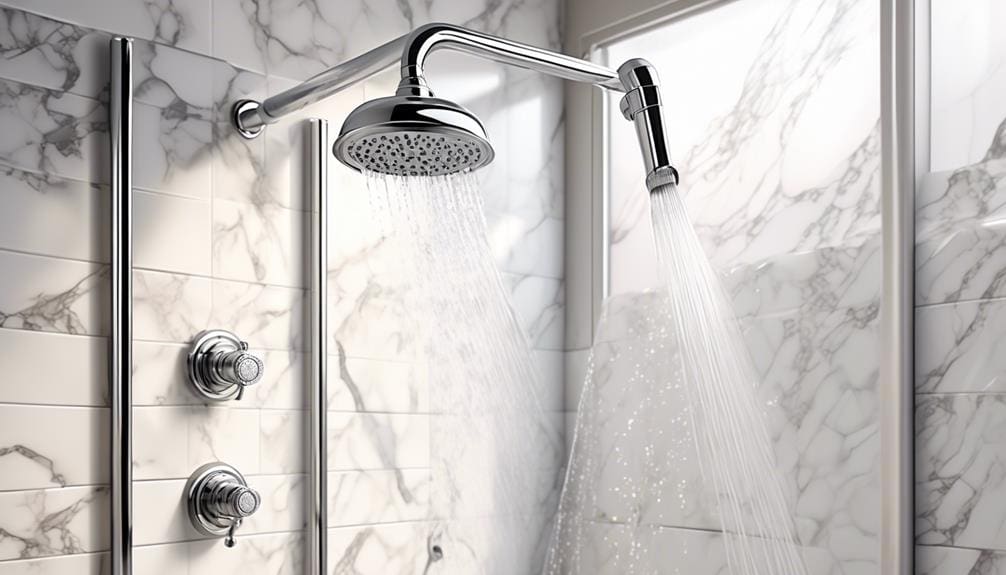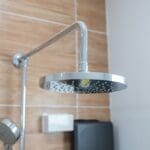When it comes to setting up your shower, navigating the waters of ideal placement for your shower head relative to the valve can feel like charting through uncharted territory. You’re in the driver’s seat when deciding how far apart these two fixtures should be, as there’s no one-size-fits-all answer.
Typically, the standard height for a shower head is around 80 inches, but this can vary based on personal preference and the heights of those using the shower. Factors such as the type of shower head, the layout of your bathroom, and specific needs like accessibility can influence this decision.
By understanding the standard distance guidelines and considering the unique aspects of your own situation, you’ll be well on your way to creating a shower setup that’s both functional and comfortable for everyone. Stick around to discover practical tips and tricks that will ensure your shower setup meets your needs perfectly, leaving you with a space that’s as refreshing as it is practical.
Key Takeaways
- Shower head height can vary based on personal preference and user heights.
- Adjustable shower heads or multiple shower heads can cater to different preferences.
- Consider the type of shower (wall-mounted, hand shower, or rain shower) when planning installation.
- Measure for multiple shower heads, considering different heights and preferences.
Standard Distance Guidelines
When considering the placement of your shower head, it’s important to note that standard heights typically fall around 80 inches from the floor. This height ensures that the shower head is accessible and comfortable for most users, while also providing an optimal water flow and spray pattern.
However, it’s crucial to remember that there’s flexibility in these measurements to suit personal preferences and the physical requirements of all users in your home.
For individuals who fall outside the average height range of 5 to 6’6′ tall, shower heads can be adjusted anywhere between 68 to 86 inches. This variation accommodates everyone, ensuring a comfortable and efficient shower experience regardless of stature.
Moreover, the absence of a standard shower head height code allows for customization based on individual needs and preferences.
To maximize versatility, consider installing an adjustable shower head or incorporating multiple shower heads at different heights. These options provide flexibility and can cater to the diverse needs of each user.
Factors Affecting Placement
Having established the standard height guidelines, let’s now explore the factors that influence where to place your shower head for an optimal showering experience. Your shower’s height isn’t a one-size-fits-all decision. It hinges on personal preference and the heights of those using the shower. If you’re setting up a shower for multiple users, consider adjustable shower heads or installing multiple ones to cater to different preferences.
For a rain shower, which mounts on the ceiling, aim for a height of 85 to 90 inches above the shower floor. This placement ensures a luxurious rainfall experience that envelops you completely.
Meanwhile, handshowers, known for their detachability and flexibility, should be installed at heights ranging from 72 to 78 inches. This range accommodates various personal shower needs effectively.
Most commonly, wall-mounted shower heads are positioned at about 80 inches from the floor, a height accessible for users of average stature.
Measuring for Installation
To ensure your shower setup meets everyone’s needs, start by measuring the distance from the shower valve to the desired height of the shower head. This initial step is crucial for a successful installation, ensuring comfort and functionality in your bathroom.
Here’s a concise guide to measuring for installation:
- Consider the tallest person in the household: The standard height of the shower head should accommodate them without forcing them to duck or bend.
- Take into account special needs and accessibility: If anyone in your home requires seated showering or other accommodations, adjust the height accordingly.
- Ensure comfort for all users: The height should allow for a comfortable showering experience, without the need to strain or reach.
- Plan for multiple shower heads: If your design includes several shower heads, measure for each, keeping in mind different heights and preferences.
- Use a tape measure for accuracy: For precise measurements, a reliable tape measure is your best tool, ensuring that your installation aligns with your planning.
Adjusting for Shower Types
Selecting the right shower head height is essential for accommodating the diverse needs of individuals in your home. The ideal height for shower fixtures varies depending on the type of shower experience you’re aiming for and the physical requirements of the users.
For a standard setup, wall-mounted shower heads are most common and are typically installed around 80 inches high. This height suits the average person and provides a comfortable shower experience.
If you prefer a rain shower, which is mounted to the ceiling for a more luxurious feel, aim for a height of 85 to 90 inches. This placement enhances the rainfall effect, enveloping you in water without spraying directly in your face.
Handshowers offer the most flexibility, installed anywhere from 72 to 78 inches high, they’re perfect for targeting specific areas and can be adjusted easily to suit children and adults alike.
For those who enjoy a more customized shower experience, combination shower heads—like bar-mounted or multi-head showers—allow for adjustable heights. This means each member of your household can tailor the shower to their preference, ensuring everyone enjoys the perfect shower experience.
Practical Tips and Tricks
After covering the optimal heights for various shower types, let’s explore some practical tips and tricks to ensure your shower setup meets everyone’s needs effectively. Whether you’re installing a luxury shower or simply upgrading your current one, these suggestions can make a big difference:
- Adjust the height based on the tallest user, but also consider a hand shower for added flexibility. This ensures that everyone, regardless of height, can have a comfortable experience.
- For a luxury shower feel, install rain shower heads at 85 to 90 inches above the shower floor. This height mimics a natural rainfall, providing a unique and immersive experience.
- Use adjustable shower heads or install multiple ones at different heights. This not only caters to all family members but also adds a touch of sophistication to your bathroom.
- Remember to adjust shower doors or curtains if you opt for a non-standard shower head height. This is crucial to prevent water from escaping the shower area.
- Consider the type of shower—wall-mounted, hand shower, or rain shower—when planning the installation. Each type has its ideal height that maximizes functionality and comfort.
Frequently Asked Questions
How Far Should the Shower Valve Be From the Shower Head?
You should place your shower valve within easy reach from the shower head, typically a few inches away, for convenient control without having to stretch or move out of the water’s flow.
Where Is the Standard Placement of a Shower Valve?
You’ll find the standard shower valve placement at 28 inches from the floor in shower stalls and 48 inches in bathtub showers. It’s crucial to get these heights right for optimal shower function.
Where Should a Shower Head Be Placed?
Your shower head should ideally be placed around 80 inches high, but you’ve got flexibility based on your preference. Options like adjustable heights or multiple heads cater to everyone’s needs, making your shower perfect for you.
Should Shower Valve Be Flush With Tile?
Your shower valve should indeed be flush with the tile for a seamless and professional look. This ensures easy access, prevents water leakage behind walls, and maintains the aesthetic appeal of your shower setup.





